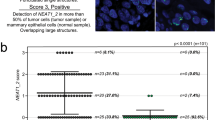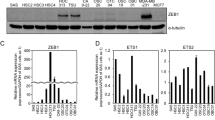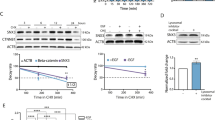Abstract
The >30 known members of the Ets multigene family of transcriptional regulators are increasingly being recognized for their involvement in early embryonic development and late tissue maturation, directing stage-specific and tissue-restricted programs of target gene expression. Identifiable primarily by their 85 amino acid ETS DNA-binding domain and dispersed across all metazoan lineages into distinct subfamilies, Ets genes also produce malignancies in humans and other vertebrates when overexpressed or rearranged into chimeras retaining the ETS domain, suggesting that their oncogenic potential is determined by the program of target genes they regulate. Searching for Ets factors that regulate expression of the HER2/neu (c-erbB2) oncogene in human breast cancer, we identified a new epithelium-restricted Ets encoding an ETS domain homologous to the Drosophila E74/human Elf-1 subfamily, an amino-terminal region (A-region or Pointed domain) homologous to the distantly related Ets-1 subfamily, and a serine-rich box homologous to the transactivating domain of the lymphocyte-restricted High Mobility Group (HMG) protein, SOX4. Recombinant protein encoded by ESX (for epithelial-restricted with serine box) exhibits Ets-like DNA binding specificity in electrophoretic mobility shift assays and, in transient transfection assays, transactivates Ets-responsive promoter elements including that found in the HER2/neu oncogene. ESX is located at chromosome 1q32 in a region known to be amplified in 50% of early breast cancers, is heregulin-inducible and overexpressed in HER2/neu activated breast cancer cells. Tissue hybridization suggests that ESX becomes overexpressed at an early stage of human breast cancer development known as ductal carcinoma in situ (DCIS).
This is a preview of subscription content, access via your institution
Access options
Subscribe to this journal
Receive 50 print issues and online access
$259.00 per year
only $5.18 per issue
Buy this article
- Purchase on Springer Link
- Instant access to full article PDF
Prices may be subject to local taxes which are calculated during checkout
Similar content being viewed by others
Author information
Authors and Affiliations
Rights and permissions
About this article
Cite this article
Chang, CH., Scott, G., Kuo, WL. et al. ESX: a structurally unique Ets overexpressed early during human breast tumorigenesis. Oncogene 14, 1617–1622 (1997). https://doi.org/10.1038/sj.onc.1200978
Received:
Revised:
Accepted:
Issue Date:
DOI: https://doi.org/10.1038/sj.onc.1200978
Keywords
This article is cited by
-
Embryonic ethanol exposure alters expression of sox2 and other early transcripts in zebrafish, producing gastrulation defects
Scientific Reports (2020)
-
Increased expression of EHF via gene amplification contributes to the activation of HER family signaling and associates with poor survival in gastric cancer
Cell Death & Disease (2016)
-
ESE1 is Associated with Neuronal Apoptosis in Lipopolysaccharide Induced Neuroinflammation
Neurochemical Research (2016)
-
The uncovering of ESE-1 in human neutrophils: implication of its role in neutrophil function and survival
Genes & Immunity (2015)
-
Epithelial-specific ETS-1 (ESE1/ELF3) regulates apoptosis of intestinal epithelial cells in ulcerative colitis via accelerating NF-κB activation
Immunologic Research (2015)



